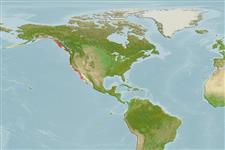Common names from other countries
Environment: milieu / climate zone / depth range / distribution range
Écologie
. Subtropical
Distribution
Pays | Zones FAO | Écosystèmes | Occurrences | Introductions
Eastern Pacific: British Columbia, Canada to Mexico.
Length at first maturity / Taille / Poids / Âge
Maturity: Lm ? range ? - ? cm Max length : 3.0 cm SHD mâle / non sexé; (Ref. 95344); common length : 2.5 cm TL mâle / non sexé; (Ref. 312); âge max. reporté: 28 années (Ref. 2823)
Description synthétique
Morphologie
Shell is thick and dark purple to black; foot is black on the sides (Ref. 312).
It has a shell length of 2.5 cm. Fisheries: Over-harvesting for food in the early 1900s, mainly by Southern European immigrants, caused a drastic drop in population numbers. Today they are still harvested by both Americans of Southern European and Asian ancestries; heavy regulation by the Department of Fish and Game has allowed populations to recover (Ref. 312). Habitat: Occurs in high to middle intertidal zones on rocky surfaces or in pools not covered in algae. Diet: eats many species of algae including micro and macroscopic. Life span: up to 25 years (Ref. 312).
Life cycle and mating behavior
Maturité | Reproduction | Frai | Œufs | Fécondité | Larves
Members of the order Archaeogastropoda are mostly gonochoric and broadcast spawners. Life cycle: Embryos develop into planktonic trocophore larvae and later into juvenile veligers before becoming fully grown adults.
Gallivan, G. and J. Danforth. 1999. (Ref. 312)
Statut dans la liste rouge de l'IUCN (Ref. 130435)
statut CITES (Ref. 108899)
Not Evaluated
Not Evaluated
Utilisations par l'homme
| FishSource |
Outils
Sources Internet
Estimates based on models
Preferred temperature
(Ref.
115969): 9.5 - 17.9, mean 11.1 (based on 132 cells).
Catégorie de prix
Unknown.
